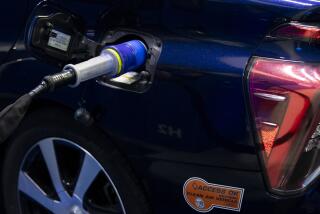Toyota executive testifies in acceleration case: ‘I am not very technical’
- Share via
Taking the stand in a $20-million product liability lawsuit, the top U.S. executive for Toyota Motor Corp. deflected questions on the technical details of his company’s cars and the costs of installing a safety system that plaintiffs contend could have saved a life.
James Lentz testified Tuesday in a Los Angeles County Superior Court, where the automaker is defending itself against a suit alleging it caused the death of Noriko Uno. Uno’s heirs say her Toyota Camry unexpectedly sped to 100 mph and crashed on an Upland street in 2009.
During about two hours of testimony, the automaker’s North American chief executive pleaded ignorance on many questions. In his 31 years at Toyota, he has focused on sales and marketing rather than manufacturing, Lentz said.
“I am not very technical,” he said.
Lentz said he couldn’t identify basic car parts when shown to him by the plaintiff’s attorney. They included a small, silver engine control module, which acts as the vehicle’s electronic brain, and a key component of the throttle system.
Prior litigation has focused on whether an electronic defect in some Toyotas triggered unintended acceleration. But the attorney for Uno’s heirs aims to prove that Toyota should have installed a low-cost brake override system in the car but didn’t. The attorney, Garo Mardirossian, says such a device — it deactivates the accelerator when a driver steps on the brake — would have prevented the accident. Toyota rejects that claim.
Although he has testified about Toyota’s sudden acceleration issues before Congress, this was the first time Lentz has appeared in product liability litigation in more than three decades at the automaker. Toyota is battling hundreds of lawsuits in recent years related to sudden acceleration.
Top auto executives rarely testify in such cases, and their attorneys try hard to keep them off the stand.
“Typically, nothing positive can come from it,” said Carl Tobias, a law professor at the University of Richmond who is tracking the Toyota litigation. “When you have a CEO subject to rigorous examination, it is possible they won’t know something, reflect poorly on the company or say something that is embarrassing.”
Toyota tried to keep Lentz from being called by the court.
“Given that Mr. Lentz has no direct, relevant knowledge of this case … we believe his videotaped deposition testimony would have been more than sufficient for the limited purpose for which it would be used,” Toyota spokeswoman Carly Schaffner said.
In his testimony, Lentz followed that script.
Mardirossian attempted to draw Lentz out with questions about why Toyota did not include a brake override system in the 2006 Camry that Uno drove and other cars sold in the United States even though it was available in Toyota vehicles sold abroad years earlier.
Lentz said he knew little about the development and availability of such systems.
Asked about when Toyota first knew of an industry phenomenon of sticking gas pedals, Lentz said he had no idea.
Asked whether brake override was meant to be a safety feature, Lentz said, “I think it can be a safety measure, but I also think it can add confidence to consumers who own our products.”
Called “Smart Stop Technology” by Toyota, it plays a key role in the automaker’s marketing of its Star Safety System.
Asked by Mardirossian whether an incident of sudden acceleration constituted a driving emergency, Lentz answered, “I think it depends on the situation.” Only on further questioning did Lentz concede that unintended acceleration had the “potential for death or injury” to car occupants.
Mardirossian wants to convince jurors that that Uno’s foot became wedged on the gas pedal after her 2006 Camry was broadsided at an Upland intersection by a Lexus driven by Olga Belo, a codefendant in the case.
That collision shifted Uno in her seat, Mardirossian said, causing the heel of her foot to become wedged. She failed to stop the car by depressing the brake with her left foot, he said, and the Camry took Uno on a harrowing 2,600-foot drive against traffic on Euclid Street. She lost control as she evaded oncoming vehicles; the car careened into a telephone pole before smashing into a large pepper tree.
However, Vincent Galvin Jr., an auto product liability attorney representing Toyota, said an override system would not have prevented the accident that killed Uno, a 66-year-old bookkeeper. Further, he has argued that her Camry had no defect, and that the automaker should not be held liable for the absence of safety equipment it theoretically could have installed.
Galvin attributed the accident to Uno’s actions, saying she mistakenly pressed the gas pedal instead of the brake.
A judge has designated the suit as a bellwether case that will help set the direction for hundreds of similar lawsuits against the automaker. Attorneys said the trial could last into October.
Already, Toyota has spent well over $1 billion settling lawsuits involving allegations of unintended acceleration, but the world’s largest automaker still faces hundreds of other cases awaiting trial.
Toyota settled the most notorious acceleration case — involving a California Highway Patrol officer who was killed along with his family — for $10 million in late 2010. It also settled a class-action suit filed by people contending that defects hurt the value of their cars, agreeing to pay as much as $1.6 billion. That settlement was finalized by a federal judge in Orange County last month.
Toyota has said that there are no electronic defects in its cars that would cause sudden acceleration, and that some of the reported events have been caused by drivers mistaking the gas pedal for the brake. Toyota still faces about 300 personal injury and death lawsuits in state and federal courts related to sudden acceleration.
Twitter: @latimesjerry







